|

 Up
Up 
 The June Bug
The June Bug 
(You are here.)



  Need
to Need
to
find your
bearings?
Try
these
navigation aids:
If
this is your first
visit, please stop by:
Something
to share?
Please:



|
|
Available in Française, Español, Português, Deutsch, Россию,
中文,
日本, and others.
 n
the summer of 1908, the Wright brothers were well ahead of any
other group of aeronautical experimenters on the planet by virtue of having
developed a practical,
passenger-carrying airplane. But news of their success had motivated other
talented and determined engineers, and some of these were catching
up. The next important aviation
milestone was passed not by the Wrights, but by the new kids on the
aviation block, the Aerial Experiment Association under the guidance of
Alexander Graham Bell – "Bell's Boys" as they were sometimes called. n
the summer of 1908, the Wright brothers were well ahead of any
other group of aeronautical experimenters on the planet by virtue of having
developed a practical,
passenger-carrying airplane. But news of their success had motivated other
talented and determined engineers, and some of these were catching
up. The next important aviation
milestone was passed not by the Wrights, but by the new kids on the
aviation block, the Aerial Experiment Association under the guidance of
Alexander Graham Bell – "Bell's Boys" as they were sometimes called.
Mindful of how prizes had helped spur European aviation, the Aero Club
of America and Scientific American magazine partnered to offer their own
incentive – a silver sculpture called the Scientific American
Trophy.
This sculpture would be awarded each year to recognize a significant
achievement in aviation, they announced. When they unveiled the prize in 1907, the Aero
Club announced that they would award it for the first time to the first
individual to fly a kilometer in a straight line.
This was a "gimmee" for the Wright brothers, or so the
presenters
thought. Scientific American magazine had initially been skeptical
of the Wright claims, and the editors were now anxious to mend fences with
the inventors as their work drew more attention. The Aero Club had been
supportive of the Wrights since the club's outset. They had been among the
first to investigate the Wright's claims, then endorse them as the
first to develop an airworthy aircraft. Many in the club counted
themselves as supporters, even good friends of the Wrights. Allan Hawly, the
president of the club,
had treated Wilbur to a balloon ride when they met in France.
Bell's Boys completed their third aircraft in the late spring of 1908,
the first designed by Glenn Curtiss. Like the White Wing, it had
ailerons, a rudder, and front and back elevators. Unlike previous AEA
aircraft, it wasn't called after the color of the cloth used to cover the
wings. Instead, Glenn Curtiss gave the honor of naming the aircraft to
Mrs. Malinda Bennitt, a friend who had helped him out when he was just
starting his manufacturing business. The gesture so flustered her that
"my old head just wouldn't work." Alexander Graham Bell came to
her rescue, and for reasons lost to history, he picked "June
Bug" – perhaps because it was
completed in June.
This was also the first AEA airplane that wasn't covered in
closely-woven silk. It used a fine weave of cotton and the
Association members were amazed at the difference in performance. On
20 June 1908, they made three attempts to get the June Bug
off the ground with no success. They reasoned that air was bleeding
through the cloth, reducing lift. Their solution was to treat the
wings with a mixture of gasoline and paraffin to seal the fabric.
This mixture was called "canvas paint" and had long been employed by
sailors to seal their sails, making them more aerodynamically
efficient as well as less susceptible to mildew. The Wright brothers
almost certainly used something similar while experimenting in Kitty
Hawk, but this was the first recorded use of what would later be
called "wing dope."
Curtiss made three successful flights in the June Bug on June
21, and within a week he was breaking his own records with flights of over
1000 yards (914 meters). The AEA was within spitting distance of flying a
kilometer. Satisfied that they could capture the Scientific
American Trophy, they cabled the Aero Club that they would make a run for it on
July 4.
The request caught the Aero Club by surprise, and the secretary, August
Post, informed Charles Munn, the publisher of Scientific American. Munn
cabled Orville, offering to postpone the AEA attempt if Orville wanted
to try for the trophy himself. Orville, unfortunately, was swamped. He,
Charlie Taylor, and Charlie Furnas were working around the clock trying to
get an aircraft ready to fly for the U.S. Army trials. On top of that,
Wilbur had asked him to write
an article for
The Century magazine that
would help establish their position as the first to make a controlled,
sustained flight in a powered aircraft. Finally, the Aero Club rules said
the plane had to make an unassisted take-off. With everything else
he had to do, Orville would have to put wheels on his airplane and find a
field big enough to make a take-off run. He declined.
Twenty-two members of the Aero Club arrived in Hammondsport, New York
on July 4 to witness Curtiss's flight, among them
Charles Manly who had piloted the unsuccessful Langley Aerodrome in
1903 and
Augustus Herring who, with Octave Chanute, had developed the
milestone Chanute-Herring glider of 1896. The AEA had laid out a course
of flight, beginning at a racetrack and continuing over clear, level
fields. A flag marked the distance of one kilometer from the starting
point. The mood at Hammondsport was festive but the weather was uncooperative;
winds and rain delayed the flight until well into the evening. At 7:00
p.m., Curtiss took off in the June Bug, climbed to an altitude of
40 feet, and landed immediately – the airplane had been rigged
incorrectly, making it impossible to keep the nose up. After adjusting the
rigging, he flew again. Curtiss later described the flight:
"When I gave the word to let go, the June Bug skimmed along over
the old race track for perhaps two hundred feet, and then rose
gracefully into the air. The crowd set up a hearty cheer, as I was
told later, for I could hear nothing but the roar of the motor, and
I saw nothing but the course and the flag marking the distance of
one kilometer. The flag was quickly reached and passed, and still I
kept the airplane up, flying as far as the open field would permit,
and finally coming safely down in a meadow, fully a mile from the
starting place. I had thus exceeded the requirements, and had won
the Scientific American Trophy for the first time."
When the distance was totaled, Curtiss had traveled 5,360 feet
(1634 meters) in 1 minute and 40 seconds. He was the toast
of both the American and European newspapers.
The Wrights, even though they had declined to compete for the trophy,
did not fail to take notice. Orville wrote a stern note to Curtiss on July
20, reminding him that he and Wilbur had shared information with the AEA
freely. The Wrights would allow them to use the patented control system
for experimentation, but Orville warned, "We did not intend to give
permission to use the patented features of our machines for exhibitions or
in a commercial way." It was the first of many such communications
that the Wrights would exchange with Curtiss.
|
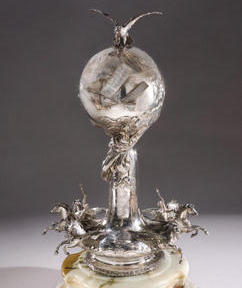
The 1908 Scientific American
Trophy. Note the Langley Aerodrome on the globe.
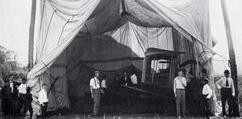
Assembling the June Bug
in a tent hangar.
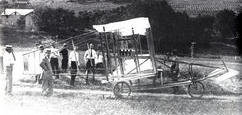
Roll out of the completed
June Bug.
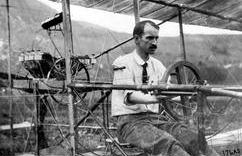
Glenn Curtiss in the cockpit of the
June Bug.
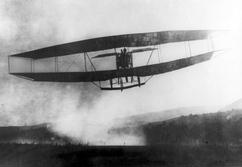
The June Bug in flight on July 4, 1908.

Curtiss and other "Bell's Boys" gathered
around the June Big after a triumphant flight.
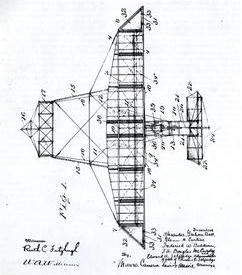
The patent drawing for the June Bug. Nos. 32
are the triangular ailerons the AEA used for roll control.
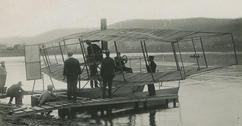
After successfully capturing the
Scientific America Trophy, the AEA made an unsuccessful attempt
to covert the June Bug into a
hydroplane. The airframe was mounted on pontoons and given a new name --
the Loon. The unstepped design
of the pontoons and the lack of power made it impossible for the
Loon to separate from the
surface of the water, but this was nonetheless one of the first serious
experiments with hydroplanes in America. |